The red-breasted nuthatch is a small songbird. The adult has blue-grey upperparts with cinnamon underparts, a white throat and face with a black stripe through the eyes, a straight grey bill and a black crown. Its call, which has been likened to a tin trumpet, is high-pitched and nasal. It breeds in coniferous forests across Canada, Alaska and the northeastern and western United States. Though often a permanent resident, it regularly irrupts further south if its food supply fails. There are records of vagrants occurring as far south as the Gulf Coast and northern Mexico. It forages on the trunks and large branches of trees, often descending head first, sometimes catching insects in flight. It eats mainly insects and seeds, especially from conifers. It excavates its nest in dead wood, often close to the ground, smearing the entrance with pitch.
Red-breasted nuthatch
The nuthatch's habit of wedging seeds into cracks and hammering them open has given rise to its common name.
The Corsican nuthatch is a species of bird in the nuthatch family Sittidae. It is a relatively small nuthatch, measuring about 12 cm (4.7 in) in overall length. The upperparts are bluish gray, the underparts grayish white. The male is distinguished from the female by its entirely black crown. The species is sedentary, territorial and not very shy. It often feeds high in Corsican pines, consuming mainly pine nuts, but also catching some flying insects. The breeding season takes place between April and May; the nest is placed in the trunk of an old pine, and the clutch has five to six eggs. The young fledge 22 to 24 days after hatching.
Corsican nuthatch
The first plate depicting the species, in this case a pair (male above and female below), and accompanying the June 1884 publication by Richard Bowdler Sharpe.
A female in the gorges of Restonica near Corte, has a dark gray crown towards the front blending rapidly into the gray-blue of the back.
The Corsican nuthatch is an agile bird that likes to prospect upside down.






